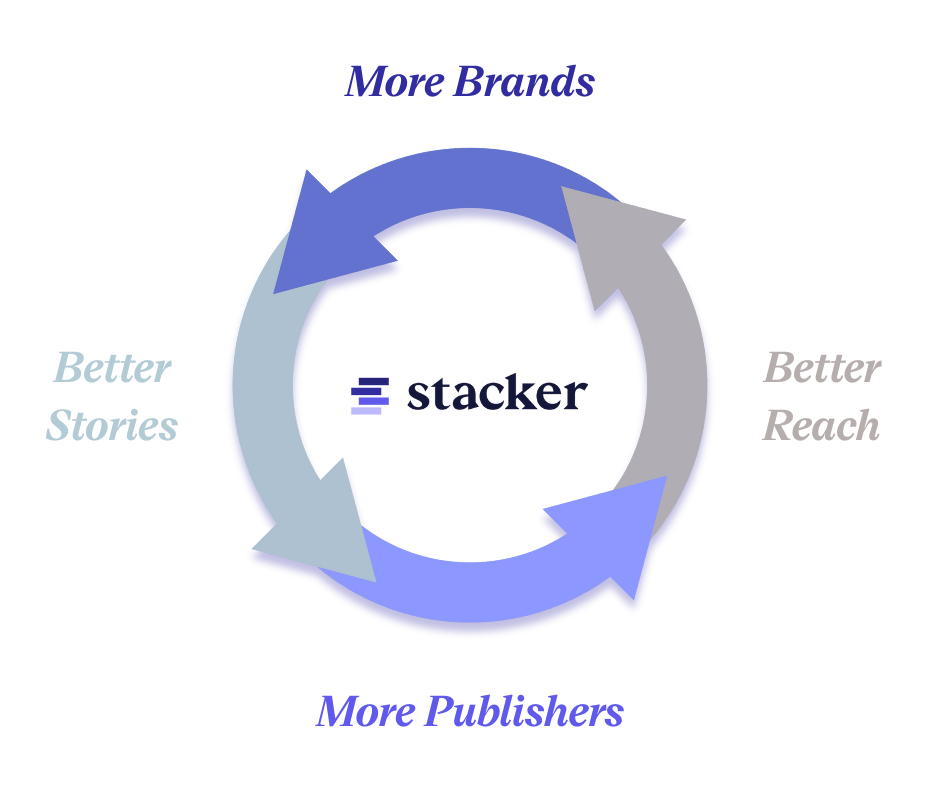When most people think about tech companies, they think about SaaS. And for good reason: Software-as-a-service models have dominated the business landscape for over a decade. But platforms - and marketplaces in particular - are a different kind of business altogether. And some of the most impactful products of the past 20 years - from Airbnb and Uber to Facebook and the App Store itself - have found ways to connect multiple parties and create 1+1=3 magic in the process.
I’ve been thinking about this a lot recently, and more specifically, what ramifications that has for Stacker.
SaaS vs. Platform: Why the Difference Matters
In a typical SaaS business, growth is about adding more logos and generating more revenue. Each new customer is valuable, but they don’t affect the product experience for anyone else. It’s a one-to-one relationship.
Platforms work differently. They operate more like ecosystems. Each participant has the power to improve or weaken the overall product. Think about Airbnb: every new host with a great property makes the platform better for travelers. But if too many low-quality or misleading listings are added, the entire experience suffers. Guests won’t come back.
The same dynamics are at play for Stacker. Every story contributed to the Newswire influences the product. Great content enhances the Newswire and helps publishers find stories worth republishing. Poor content does the opposite. That’s why we have rigorous editorial standards, and a focus on quality, not just quantity.
Building a Flywheel
A strong platform creates a flywheel effect that builds momentum over time. Think of how Amazon built its marketplace. Low prices attracted more customers. More customers attracted more third-party sellers. More sellers increased product selection, which brought in even more customers. Each part of the system reinforced the others, creating exponential growth without constant reinvention.
The same dynamic is at play with Stacker. High-quality content increases the value of our Newswire for publishers. When more publishers engage, the platform becomes more attractive to contributing orgs. And as more teams contribute better content, the Newswire grows in breadth and value.
That cycle is already in motion, and our goal is to keep it spinning faster by delivering better stories, expanding coverage, and driving real value on both sides of the platform. And to accelerate the flywheel, we start with the most critical part of the ecosystem: publishers.

Putting Publishers First
We believe strong publisher relationships are central to long-term success, both for Stacker and for the teams that publish through us. Making the Newswire indispensable means delivering stories that editors actually want to run. That doesn’t mean more content for the sake of volume. It means better stories, with more thoughtful reporting and clear relevance. A few examples:
Stories that reflect real audience interests.
Much of the coverage around tax season 2025 focuses on delayed filings, reduced refunds, and the end of pandemic-related credits. Ramp took a different approach by translating IRS data into practical strategies that help business owners save money, avoid errors, and plan more effectively throughout the year.
Angles that stand out in a crowded news cycle.
The White Lotus often generates press focused on its satire, style, and cultural impact. Compartes offered a fresh perspective by showing how the show influences consumer behavior and brand storytelling, turning entertainment into a lesson in modern marketing.
Reporting that is grounded in credible data and useful context.
Yardi Systems recently published a ranking of the best cities for women in tech using U.S. Census data and CoworkingCafe’s proprietary index. The result is a clear, informative story that offers valuable insights for professionals and decision-makers alike.
When the Newswire delivers this kind of consistent value, publishers come back. And when they do, brands benefit from greater reach and more meaningful exposure. But this all needs to start with brands remembering that distribution shouldn’t be an afterthought once your content is built. It needs to be included from the very beginning of the content creation process.
Distribution as a Strategy (and the Reward)
Many companies treat distribution as the final step. At Stacker, we see it as something much more powerful. It’s a tool for shaping content strategy from the beginning.
The teams that perform best on our platform are the ones that think about editors and readers from day one. They ask what stories are worth telling, and how to tell them in a way that earns attention. They prioritize originality, usefulness, and clarity.
We’re already seeing brands shift how they create content based on what gets picked up and shared. That kind of alignment between content creators and publishers is what keeps the platform healthy and growing.
Building with Purpose
Being a platform is about more than scale. It comes with the responsibility to raise the bar. Because every contributor affects the product, the stakes are higher. But so is the potential to make a real impact.
By working with brands that care about creating meaningful content, and with publishers who expect the best, we have a chance to build something that transforms content distribution for the better.
And we’re just getting started.
Noah Greenberg is the CEO of Stacker, the first content distribution platform built for earned reach. He’s led the company in redefining how brands and publishers collaborate, with over 4,000 news outlets using Stacker to enhance coverage. A Forbes 30 Under 30 honoree, Noah previously helped scale Graphiq, later acquired by Amazon.
Featured Image Credit: Photo Illustration by Stacker // Canva